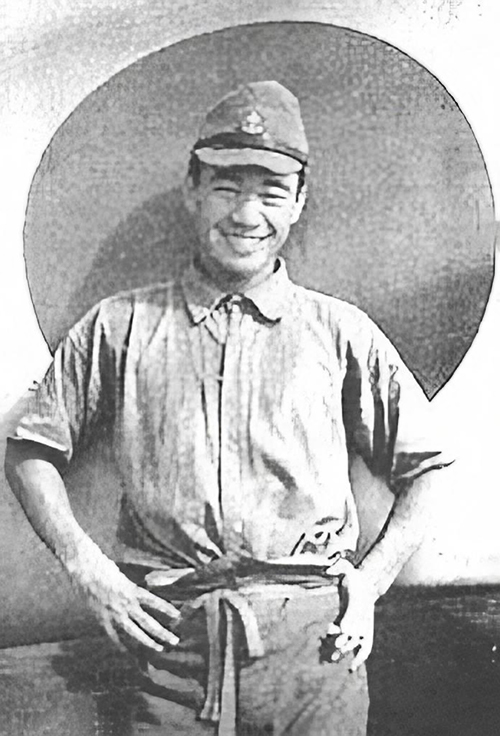Sakai Saburō

Sakai Saburō ( Japanese 坂 井 三郎 ; born August 16, 1916 in Saga Prefecture , Japan ; † September 22, 2000 in Atsugi , Kanagawa Prefecture ) was a Japanese fighter pilot . He gained fame during the Second World War through his missions for the Japanese Navy Air Force in the Pacific (1941–1945). 64 kills of enemy aircraft are assumed.
Early life
Sakai was the third of four sons and had three sisters. He was eleven years old when his father died, leaving Sakai's mother and seven children. In 1933, at the age of 16, he joined the Japanese Navy . There he was a gunner on the battleship Kirishima until he was taken over by a flight school in 1936. He completed his first mission in the Second Sino-Japanese War , where he shot down a DB-3 bomber built in the Soviet Union with an A5M .
Use in the South Pacific
When the war with the United States began, Sakai was there in the first attack on the Philippines . On December 8, 1941, he flew one of the 45 Mitsubishi A6M 2 that attacked Clark Airfield in the Philippines. That day he had his first aerial combat against the Americans and shot down a Curtiss P-40 . On the third day of the battle, he shot down the first Boeing B-17 during the war. In early 1942 Sakai was stationed in Borneo . The high command of the Japanese armed forces ordered that any enemy aircraft be shot down; whether armed or not. One day Sakai spotted a Dutch DC-3 with civilians on board with his Zero . Sakai decided, contrary to his orders, not to shoot down the civilian plane and signaled the pilots to flee. Thereupon the pilot and the passengers saluted out of respect for the knightly fighter pilot.
During the Borneo Offensive, Sakai managed to score thirteen aerial victories. During the next few months he tried to pass on his gained experience to young pilots. On August 3, 1942, the Sakai promoted to Ittō Hikō Heisō and his squadron were moved to Rabaul .
On August 7th , the Americans and Australians landed at Guadalcanal . The combat strength of the Japanese air force was soon surpassed by the Allies . The Japanese were only able to keep the air powers in balance with ever new strategies and suicidal operations. During a Battle of Guadalcanal, American in Sakai already three F4F -Jagdflieger had shot, he discovered a group of eight Dauntless - dive bombers , which he mistakenly believed to be fighters and attack from behind. As a result, he got caught in the concentrated defensive fire by their rear gunner, where he received a headshot that blinded the right eye. Despite his serious injury and repeated kamikaze thoughts , Sakai made it back to his base in Rabaul in 4 hours and 47 minutes and 1040 kilometers. After landing, he reported his flight report to the commander before collapsing. Sakai was flown back to Japan. After five months of recovery, he devoted himself to training young pilots.
In April 1944 he was transferred to Iwojima . Despite the loss of his right eye, he achieved great success, for example, on July 24, 1944, he escaped 15 F6F Hellcat pilots without taking a bullet. In August 1944 he was promoted to lieutenant at sea. At the end of the war, Sakai received a kamikaze order , but he could not find the target.
Sakai survived the war without being shot down by enemy warplanes. Like the Finnish fighter pilot Ilmari Juutilainen , Sakai never lost any of his wingmen in combat. Its kill rate is estimated at 64 and more. After the war he moved away from everything military and chose a civil life.
While running a printing company, he wrote many books about his military experience. His main work is "The Samurai of Heaven" ( 大 空 の サ ム ラ イ , Ōzora no samurai ), which has been translated into many languages. The book is said to have helped, especially in the West, to remove prejudices about Japanese pilots from the war and to have shown that Japanese pilots had the same thoughts as Western pilots.
Since his daughter Michiko married the American soldier Terence Smart, he had several opportunities to travel to the USA. After getting the chance to pilot a P-51 Mustang , he stepped back from claiming that the Mitsubishi A6M was the best aircraft.
On September 22, 2000, he attended a ceremony at the American military base in Atsugi . Feeling bad at the banquet, he was admitted to a hospital where he died that same day at the age of 84.
literature
- Lisle Abbott Rose: Power at sea . Volume 2: The breaking storm. 1919-1945 . University of Missouri Press, Columbia Mon. 2007, ISBN 978-0-8262-1702-8 .
- Henry Sakaida: Winged Samurai. Saburo Sakai and the Zero fighter pilots . Champlin Fighter Museum Press et al., Mesa Ariz. 1985, ISBN 0-912173-05-X .
- Henry Sakaida: Imperial Japanese Navy Aces 1937–45 . Osprey Publishing, Westminster, Md 1998, ISBN 978-1-85532-727-6 , ( Osprey Aircraft of the Aces 22).
- Saburō Sakai, Martin Caidin , Fred Saito: Samurai! Bantam, Toronto et al. 1978, ISBN 0-552-61035-6 , ( Bantam war books ), (English first edition: Dutton, New York 1957; Kimber, London 1959).
Remarks
- ↑ 一等 飛行 兵曹 , corresponds to the English Air Petty Officer, First Class
| personal data | |
|---|---|
| SURNAME | Sakai, Saburō |
| ALTERNATIVE NAMES | 坂 井 三郎 (Japanese) |
| BRIEF DESCRIPTION | Japanese pilot |
| DATE OF BIRTH | August 16, 1916 |
| PLACE OF BIRTH | Saga , Japan |
| DATE OF DEATH | September 22, 2000 |
| Place of death | Atsugi , Kanagawa Prefecture |

